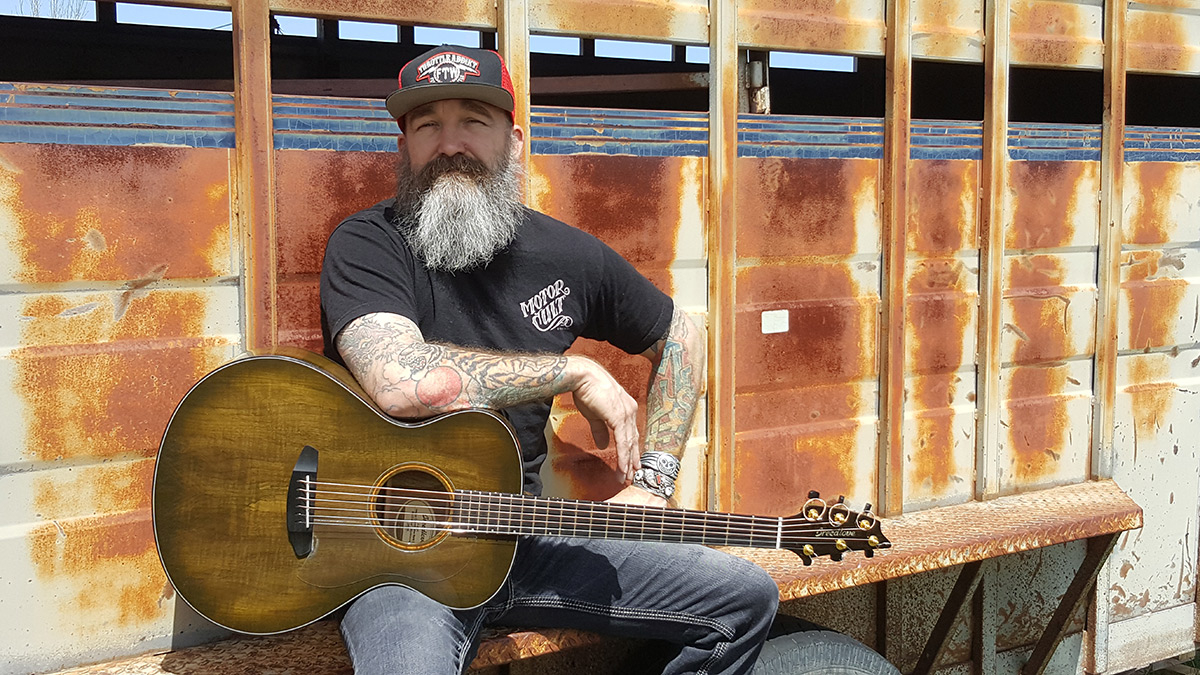
Harley Osterlund with a custom myrtlewood guitar.
Harley Osterlund is a live animal. He likes to prowl the stage, he likes to feel the monitors shaking and the audience stomping its feet.
Luke Basile is a creature of the studio. He’d rather be leaning into a condenser mic, letting it hear the scrape of his skin against the strings, favoring the subtlety and spice of the moment.
Both play Breedloves.
And both have fallen in love with myrtlewood.
Due to back pain issues, Osterlund may not be high-kicking like a crazed Vegas showgirl these days—his antics with Harley & the V-Twins are well documented—but he still rocks.
After years of sideman work with serious stars, Osterlund cut loose for a decade with the latter trio, shredding solos for cheering throngs. He learned the business inside and out; and in addition to his own grueling tour schedule, he also contracted major festivals, hiring the acts, renting the gear, mixing sound and, on some nights, sweeping the stage when it was time to go.
Now, as Jukebox Hero, he blends his own epic originals with a simple dare—he’ll play any song you can name!
While Osterlund, recently relocated to Idaho, is working towards settling down, he still plays dozens of dates each season.
Basile is a little less peripatetic. He is studio manager of Rainmaker Studios in Pasco, Washington and can be found there most days deeply engaged in one phase or another of playing, tracking, mixing or mastering.

Luke Basile in Studio.
Basile is eclectic in a quieter way, exploring music of many cultures rather than the classic rock songbook.
But, as noted, both players—extremely talented and hard-working—have found their signature sound with Breedloves. And both are bent on exploring the nuances of myrtlewood.
“Microphones love the myrtle,” Basile muses. “It transfers really well.”
“The whole thing vibrates, from the butt pin all the way up to the very tip of the headstock,” raves Osterlund of his concerto. “It resonates as one piece. That’s phenomenal to me.”
Osterlund now plays seated, although he’s not exactly sitting still. His focus on a nominally more acoustic approach resulted from a club owner claiming he wanted to hear him solo.
“You put an electric guitar in my hand,” he says, “and I’ll melt faces all day long, all over the country. That was a great thrill for many, many years.”
But it had, he admits, become rote.
“I found as soon as I picked up an acoustic guitar, that the connection was right back. No ‘show,’ no doing backflips, no playing solos with my teeth, no flame throwers, no lights, none of that to hide behind. It’s the most naked form of expression that you could give to somebody, and I love the rush of it.”
Osterlund’s Breedlove is loud. Really loud. His own foldback would make some folkies’ ears bleed, and the mains just crush heads.
It’s a demanding environment for an acoustic guitar.
“Once you start amplifying the instrument, that’s a whole different beast,” he notes, emphasizing, “a whole different beast!”
When shopping, Osterlund tests his instruments in a specific way. Without taking the instrument down, he picks the G-string with his thumb.
He did so with a Breedlove myrtlewood concerto.
“I hit that string, and I heard that tone that sounded like it was coming through a PA system already. I looked over at the shop owner and he smiled this big smile. He goes, yeah, wait until you strum a chord on it. I was like, oh, man, get the ladder. Pull this thing down. I want this. I strummed that whole G chord and listened to how big and full and beautiful it sounded, and I about lost my mind. I was just like, oh my God, this can’t be true. We need to plug this in! I want to hear what this thing sounds like plugged in.”
Now his fans hear it plugged in every night.
“You get to a point where you just become numb and you’re just going through the motions,” Osterlund says. “Then when you pick up an instrument that inspires you to go back out there and keep kicking ass, that reminds you this is what you’re supposed to be doing. You can’t put a price tag on that.”
Basile’s love of Rainmaker’s myrtlewood concerto is shared by others.
“We run a public studio,” he says. “A lot of our clients will choose to use that myrtle instrument over any other acoustic in the studio. It’s a really, really nice tonewood. Not only that, but it is a fantastic look—I mean, it’s a jaw-dropper.”
“It’s eye candy at first, but then they pick it up and they play it, and they realize, not only is it eye candy, it’s ear candy, too.”
“When I pick up an acoustic,” Basile, the session master, says, “all I really want to do is play it in a room. It’s about hearing the natural sound of the guitar, like it’s supposed to be heard. When you dig into myrtle, even with a couple mics up, there aren’t any artifacts, as I would call them, that aren’t pleasant to the ear. You don’t get any of that. It gives you just what you want. You get a really nice tone out of it no matter what dynamics you’re playing at. It’s a well balanced and well-rounded sound for sure. I prefer it over mahogany or rosewood.”
